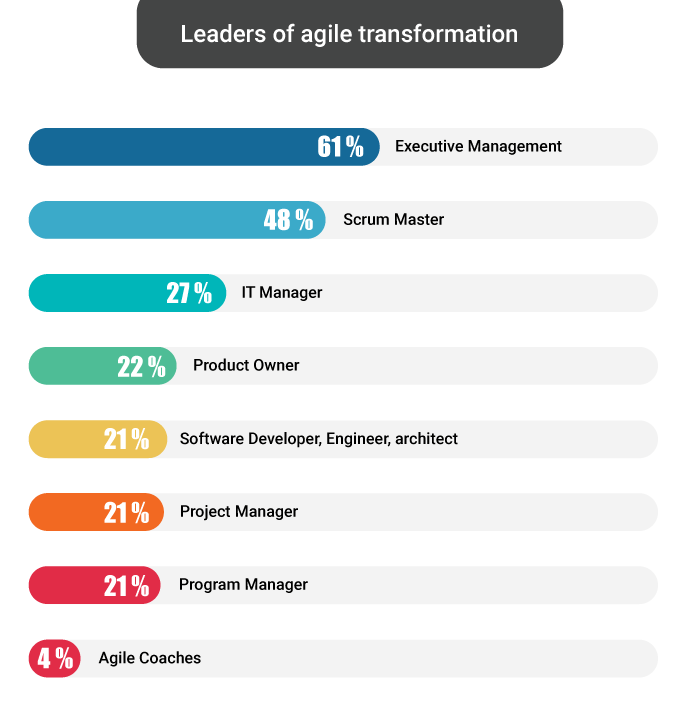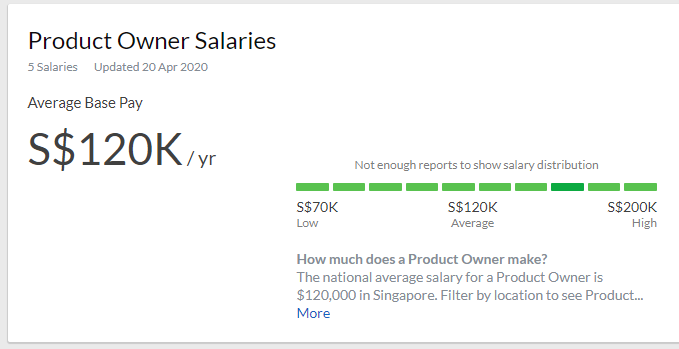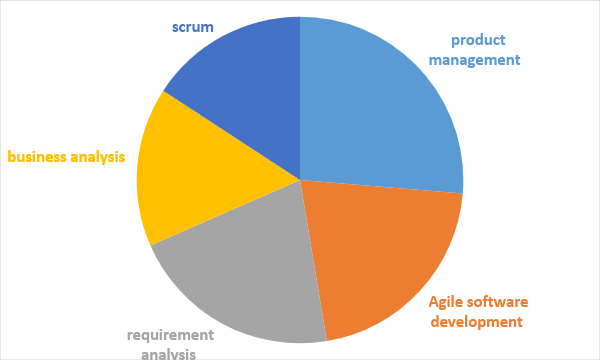
Every organization varies in the way it implements Agile. Some organizations have a single role, either product owner or project manager, while few others might employ both roles.
Product owners are measured/considered to be the center of every software development lifecycle. They are known to give heed to the requirements of customer requirements, envision the product, and can communicate the same with the development team. Their role and responsibilities differ depending on the work environment.
In the article, you will learn thoroughly about what the product owner does. Roles and responsibilities, challenges faced by the product owner, and skills and challenges.
Product Owner – Definition!
A product owner is a project leader who is responsible for maximizing the product value developed by the team.
The primary goal of the product owner is to represent the customers to the software development team and prioritize the requirement list considering further development scenarios. They have the right to change the order of product requirements in the product backlog. They must always be available to the development team to clear their queries and keep an eye on how they are implementing a specific product feature.
A product owner takes various roles such as product designer, project manager, customer liaison, market analyst, and business strategist.
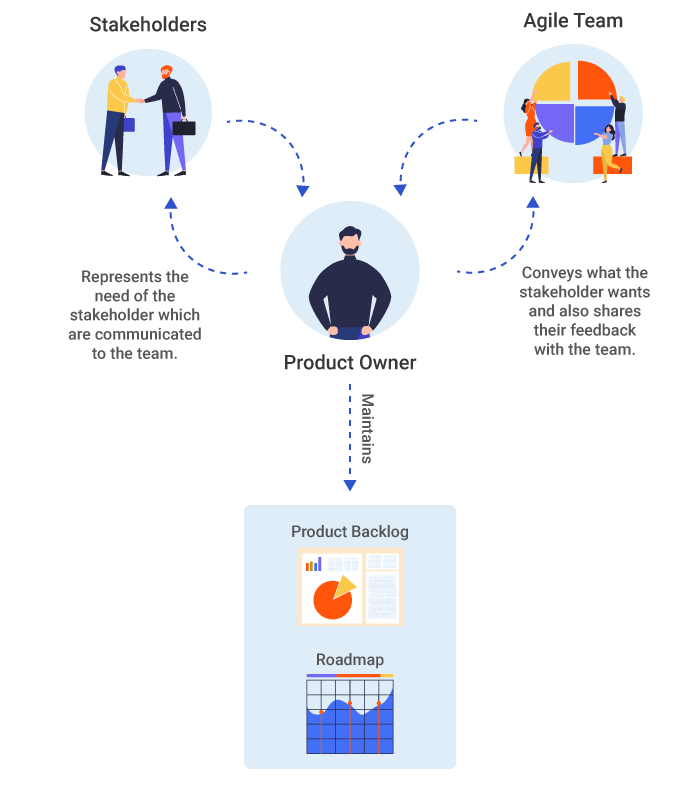
Role of the Product Owner in the Team
The product owner in the team possesses complete authority to prioritize the product features to be completed by the development team. They are aware of the time pace of how the group operates, and new requirements are added only when the previous ones are done.
Having a product roadmap helps determine a highly detailed plan to accomplish things that span over a longer duration. It also determines the product vision and keeps the stakeholders aware of how the process will be taken ahead. The product roadmap gives an overall idea of the budget required for the entire project.
The above image shows the importance of product owners while supporting executive management, IT managers, and Scrum Master. They are capable of applying new techniques and effective management approaches to take the project ahead.
Product Owner Responsibilities
Let’s take a look at the major responsibilities demanded by this role:
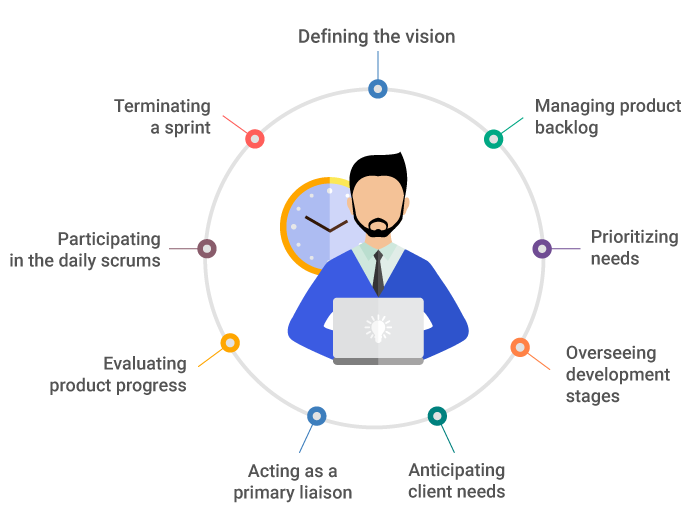
Defining Product Visualization
It’s the responsibility of the product owner to communicate and collaborate with the client/stakeholders to understand their requirements thoroughly. So, it’s inevitable for them to translate their vision to the team and talk back to the stakeholders regarding the same and provide them an in-depth understanding of the project outcome. Every individual in the group should stay in the same phase for the effective accomplishment of the project.
To ensure that every vision is aligned with the business objectives, the product owner must be able to come up with a product roadmap. A product roadmap provides a visual summary outlining the vision of the product.
Handling Product Backlog
The primary concern of the product owner is to manage the product backlog and prioritize them based on the business objectives. The product backlog list isn’t static; instead, it’s dynamic. It is a live document based on evolving project requirements.
Since the product backlog change recurrently, it is the responsibility of the product owner to create a list that is accessible to the stakeholders, including developers, to ensure improved performance.
Requirement Prioritization
Prioritizing your requirements/product backlog is pretty much essential to delivering the maximum outcome and achieving goals and missions. The scope of the project, timeline, and budget should be prioritized according to the requirements. There are assorted tools available to assist the product owners in accomplishing the task. The product owner backlog must be prioritized to the sprint planning method.
Supervising the Development Stages
With the product priorities, strategy, and vision set in place, the product owner has to spend a significant amount of time supervising product development. They are considered key players through every phase of the event. It includes planning until the sprint.
During the planning phase, the product owner works with stakeholders jointly to come up with the steps required for the next iteration. They also work with the team to identify the process, areas for improvement, and sprint process.
Check out the blog on Agile Product Development and understand the entire development process!
Understanding the Client’s Requirements
An accomplished product owner will thoroughly understand the client’s requirements to manage the development process more effectively. The product owner must be capable of understanding market competition, and the pain points of the user, and quickly determine what all essential features have to be implemented as a priority.
The product owner’s profound knowledge of the market scenario and extraordinary communication skills will help to address any type of issue.
Primary Connection
In the initial phase of our article, we discussed that a product owner acts as a primary point of contact between the development team and stakeholders. They have to ensure that information between both teams must be unambiguous and quick. They also have to ensure that goal and the vision of the product are aligned with the product backlog.
Evaluate the Progress of the Product
The product owner is responsible for the entire development process from the beginning to the final product. They ensure that the development process takes place on a priority basis. Work that is incomplete should be sequenced again.
Challenges Faced by the Product Owner
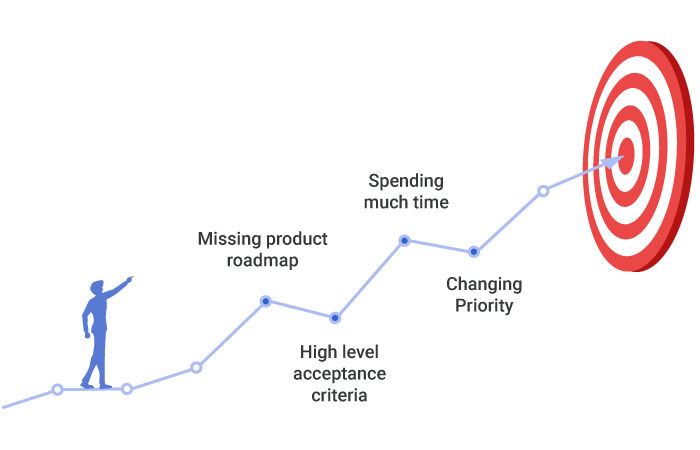
Unlike any other job role, even the product owner job role comes with a few issues challenges/issues to cope up –
1. Missing the product map
2. High-level acceptance criteria
3. Spending much time dealing with the product support
4. Changing process priority when the sprint is in progress
The product owner has the capability to escape from these issues by working on the pain points like prioritizing the high-value backlog items, working on the product roadmap, concentrating on the product backlog quality, and defining the acceptance criteria.
Skills and Competencies Required for Product Owner Job Role
The competencies required for a product owner job role are broken down into four parts:
Domain Proficiency
Having profound knowledge about the market and the product you are dealing with is the major reason you are employed by your organization. Having known your customers and the way they are utilizing your product is the reason behind hiring you as a product owner.
Improving Product Value
The main focus of the product owner is to focus on what to deliver next. An idea regarding what should be focused on an upcoming differentiated product makes you shine as an amazing product owner in the eyes of your team and stakeholders.
Customer-to-product Translator
The job role of the product owner lies between what stakeholder wants and delivering the product features. Their main role is to translate every minute detail of the customer to developers. By doing so, the product owner can make out the difference between the better and best product.
Communication Skills
We all work in a team when it comes to product development. Being a product owner, you need to listen to each technical aspect and ensure all the phases go well before the product is released into the market. Learn all the required communication and influencing skills to make your upcoming product a great one.
Product Owner’s Contribution Toward the Growth
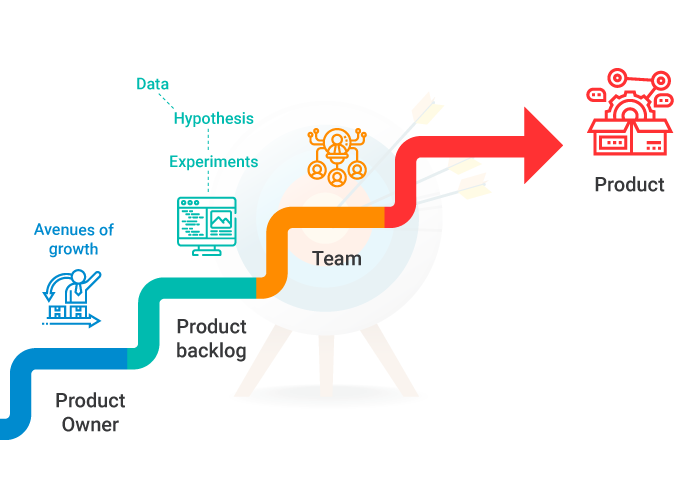
The product owner realizes the progression of the product/service during the execution phase. Keeping a clear target regarding the growth, the product owners can alter the product backlog as per the requirements and priorities. This will let the development to focus on the upcoming work to achieve the business target.
The very next step is to implement a good feedback loop. Implementing such a measure will let you know whether the initiative taken has any effect on the project or need any tweak as per requirement.
“The most reliable form of self-marketing is to have a long history of stunningly great work shipped.”
– Seth Godin
American author and former dot com business executive
In many enterprises, it consumes more time to make the data reach the product owner and the development team. So ensure to coordinate with the data with every member; doing so will shorter your feedback loop and allow every team member to reply much more quickly.
Educational Qualification and Experience
Here is a list of qualifications and experience criteria that organizations look for while hiring for product owner job roles:
- Exceptional verbal communication and documentation skills.
- People with lesser communication skills should possess amazing team management skills.
- The ability to work collaboratively with development is pretty much essential.
- Well-recorded success history in releasing products meeting business objectives.
- Subject matter expertise in a specific product and how to develop solutions for the same.
- People aspiring to flourish in this job role should have a bachelor’s degree in the same industry.
- Some can also possess added business training as well.
How Much Does a Product Owner Make/Earn?
The average salary of a product owner in the US is $120K and can go up to $200K depending upon job role and experience.
What are the Popular Skills Required for the Product Owner
Closing word Product owners have to face quite a tough time when dealing with customers and their requirements. There are many best practices and frameworks a product owner should get aligned within an enterprise. Aspiring and experienced product owners should get grained in industry-recognized Agile Courses and Project Management training programs to gain in-depth knowledge of the Product Owner’s role in transforming business offerings according to the market needs.
Some of the widely-recognized Agile Certification Courses taken up by individuals and enterprise teams are:


